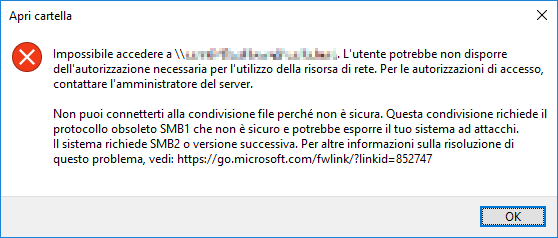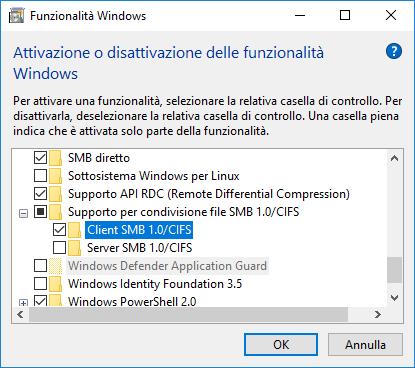Windows 10 1709 e SMBv1
Come indicato nella KB4034314 SMBv1 is not installed by default in Windows 10 Fall Creators Update and Windows Server, version 1709 il protocollo di rete Server Message Block version 1 (SMBv1) non è più installato per default nelle nuove installazioni del sistema operativo e nel caso di upgrade se l’SMBv1 client non viene utilizzato per 15 giorni (esclusi i periodi in cui il computer è spento) viene automaticamente disinstallato. La motivazione di questa scelta assolutamente condivisibile dal punti di vista della sicurezza (a riguardo di veda il mio post Ransomware WannaCry: Protezione e Best Practices) sta nel fatto che l’SMBv1 è stato sostituito dall’SMBv2 nel 2007 ed è stato deprecato nel 2014.
Di seguito i dettagli riguardanti la gestione dell’SMBv1 in Windows 10 1709 come indicato nella KB4034314:
-
SMBv1 now has both client and server sub-features that can be uninstalled separately
-
Windows 10 Enterprise and Windows 10 Education no longer contain the SMBv1 client or server by default after a clean installation
-
Windows Server 2016 no longer contains the SMBv1 client or server by default after a clean installation
-
Windows 10 Home and Windows 10 Professional no longer contain the SMBv1 server by default after a clean installation
-
Windows 10 Home and Windows 10 Professional still contain the SMBv1 client by default after a clean installation. If the SMBv1 client is not used for 15 days in total (excluding the computer being turned off), it automatically uninstalls itself.
-
In-place upgrades and Insider flights of Windows 10 Home and Windows 10 Professional do not automatically remove SMB1 initially. If the SMBv1 client or server is not used for 15 days in total (excluding the time during which the computer is off), they each automatically uninstall themselves.
-
In-place upgrades and Insider flights of Windows 10 Enterprise and Windows 10 Education do not automatically remove SMB1. An administrator must decide to uninstall SMB1 in these managed environments.
-
Automatic removal of SMB1 after 15 days is a one-time operation. If an administrator re-installs SMB1, no further attempts will be made to uninstall it.
-
The SMB version 2.02, 2.1, 3.0, 3.02, and 3.1.1 features are still fully supported and included by default as part of the SMBv2 binaries.
-
Because the Computer Browser service relies on SMBv1, the service is uninstalled if the SMBv1 client or server is uninstalled. This means that Explorer Network can no longer display Windows computers through the legacy NetBIOS datagram browsing method.
-
SMBv1 can still be reinstalled in all editions of Windows 10 and Windows Server 2016.
Questo significa che se nell’infrastruttura esistono share che utilizzano ancora SMBv1 queste potrebbero risultare inaccessibili a computer su cui Windows 10 1079 viene installato tramite una installazione da zero.

Ovviamente è possibile abilitare ancora l’uso di SMBv1 in Windows 10 179 come indicato nella KB2696547 How to detect, enable and disable SMBv1, SMBv2, and SMBv3 in Windows and Windows Server, ma questa dovrebbe essere solo un workaround temporaneo in attesa di aggiornare le share con il protocollo SMBv2 o SMBv3 e se deve per forza essere utilizzato tale workaround ovviamente è consigliabile installare solo la parte client dell’SMBv1.


[…] Abilitazione del client SMBv1 (si veda il mio post Windows 10 1709 e SMBv1) […]
[…] Sempre nella versione 1709, come indicato, era anche stato disabilitata la versione 1 di di SMB, a riguardo si veda anche il mio post Windows 10 1709 e SMBv1. […]